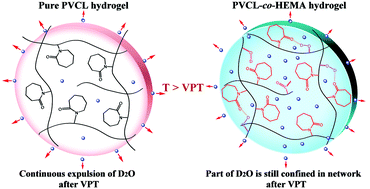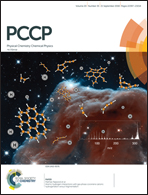Exploration of the unusual two-step volume phase transition of the poly(N-vinylcaprolactam-co-hydroxyethyl methacrylate) hydrogel†
Abstract
It is important to investigate the phase transition mechanism of stimuli-sensitive hydrogels due to its great guiding significance for the application of stimuli-sensitive hydrogels in biomedical applications. In this work, the novel thermo-sensitive poly(N-vinylcaprolactam-co-hydroxyethyl methacrylate) (PVCL-co-HEMA) hydrogel was successfully synthesized via free radical polymerization, and then temperature-dependent FTIR spectra combined with the newly developed scaling moving-window two-dimensional (scaling-MW2D) correlation spectroscopy and generalized two-dimensional correlation analysis were utilized to investigate its volume phase transition (VPT) mechanism upon heating. Conventional 1D FTIR spectra and Boltzmann fitting results revealed that the PVCL-co-HEMA hydrogel exhibited a distinct VPT behavior from the neat PVCL hydrogel due to the incorporation of PHEMA. The essential reason is that some water molecules were still confined in the PVCL-co-HEMA network after phase transition at high temperature, rather than continuously being expelled out of the gel with the increase of temperature. Scaling-MW2D spectra revealed that the phase transition of the PVCL-co-HEMA hydrogel could be divided into two steps (I and II), and further confirmed that the transition regions of these two steps were 25.0–32.3 °C and 32.3–46.8 °C, respectively. The transition regions of both these steps were obviously lower than those of the neat PVCL hydrogel. According to the generalized 2D correlation analysis of step I, we concluded that the dissociation of the hydrogen bonds between the incorporated PHEMA moieties and water molecules is the driving force for the local hydrophobic domain formation process (step I), and its occurrence at a lower temperature is the main reason for the decrease of the VPTT of the PVCL segments. Furthermore, we found that the dissociation of the hydrogen bonds between the C![[double bond, length as m-dash]](https://www.rsc.org/images/entities/char_e001.gif) OVCL groups and water molecules is the driving force for the chain collapse (step II), and the driving effect of the PVCL segments on PHEMA during the phase transition was confirmed. Combined with the obtained sequential order of steps I and II, an unusual two-step VPT mechanism for the PVCL-co-HEMA hydrogel upon heating was proposed.
OVCL groups and water molecules is the driving force for the chain collapse (step II), and the driving effect of the PVCL segments on PHEMA during the phase transition was confirmed. Combined with the obtained sequential order of steps I and II, an unusual two-step VPT mechanism for the PVCL-co-HEMA hydrogel upon heating was proposed.



 Please wait while we load your content...
Please wait while we load your content...